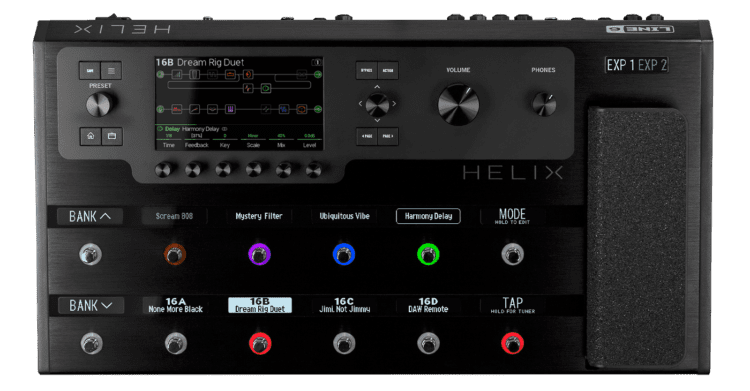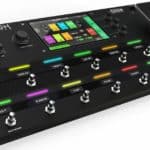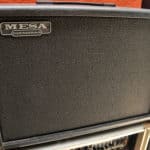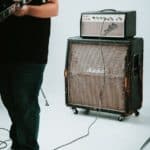Since Line 6 launched the Helix, the industry has never been the same.
Being one of the most powerful and complete multi-effects pedalboards, it’s only natural that it has become the centerpiece of many players’ rigs.
But their functionality and limitations might confuse those who are still wondering if getting a Helix is a good idea for them.
Most doubts, in my experience, come from what the Helix can and can’t do in terms of playing live with a speaker.
So, does the Line 6 Helix need a power amp to be used live?
You will need a power amp to connect your Line 6 Helix to a guitar speaker cabinet since its signal needs to be amplified. However, there are other alternatives for using your Helix live, such as going through a PA system, using powered speaker cabinets, or plugging it into an amp’s FX loop return.
In this article, I will go in-depth on how the Helix works, what you need to use it live, and what alternatives you have to do so.
After leaving this page, you will have a clear idea about the full potential of the Helix, and know if this unit might work out for you based on your playstyle and needs.
Are you ready to get started?
Let’s go!
Can you plug a Helix directly into a guitar speaker cabinet?
Sadly, connecting your Helix directly into a guitar speaker cabinet won’t work due to signal strength issues.
You see, guitar pickups generate a very weak signal that is then processed by the unit, but in no way amplified.
The Helix just works with that instrument-level signal and delivers it to the next step in the rig, which should be able to work with it.
Since the Helix does nothing for increasing this signal’s strength, going directly into a cabinet won’t work, and you will get no sound out of it.
We will discuss what your alternatives are next.
What do you need to use the Helix with a speaker cab?
To use your Helix with a guitar speaker cabinet you will need a piece of gear that increments its output signal to speaker level signal.
The most usual equipment for doing so is a power amp, you might have heard of them.
Power amps just take weaker signals and increase their level enough to properly drive speakers.
Traditional guitar amps have a preamp section, that’s in charge of pre-processing and shaping the sound, and a built-in power section that works primarily by increasing the power of the output signal.
With a Helix, you would be using it as a preamp, and then plugging it into a power amp to properly simulate the workflow of a real piece of gear.
This is, however, just if you really need your audio to go through a guitar speaker cabinet, there are some other solutions that we will discuss later.
Do power amps and cabs affect the sound of your Helix?
Running your Helix rig through a power amp and a cabinet will ultimately affect your tone.
Each extra step your signal passes through is very likely to affect it for best or for worse.
Particularly, power amps and cabinets are very likely to affect your tone.
Here’s an article I wrote about how cabinets shape your sound:
Here’s one about speakers:
And here’s one about how different tube power sections also do so:
As you can see, every part of the process is important, and you should pay attention and learn to work with it.
However, I think that adding a power amp and a real cabinet to your rig can only make your sound more natural.
Should you use cab simulation or IRs if you use your helix with a real cab?
As you might know, most effect processors nowadays, including the Helix, incorporate cabinet simulation and the ability to load impulse responses, which ultimately act as a way of emulating an actual speaker.
When you decide on using your unit with an actual cab, it’s recommended you deactivate the cab or IR block from your rig, since you will be overcompensating for it.
Perhaps you can find a way to make it work, and I encourage you to try all your sounds with and without it, but do it consciously, and experiment with it.
Stacking cab simulations or IRs with real cabs might make your final tone end up sounding flat, filtered, and overprocessed since you can think of these simulations and impulse responses as dynamic EQs, in a way.
You would be adding EQ after EQ after EQ to no avail.
Best power amps to use alongside a Line 6 Helix
I’ll be honest, I think most power amps will do the job just fine, so any of these will most likely work out for you.
Here is a list of some proven alternatives for powering a Helix signal up to speaker level:
- Fryette Power Station
- Seymour Duncan Power Stage
- EHX 44 Magnum
- Palmer Macht 402
- Matrix GFX 800
For more details on each of these amps, please check out their manufacturer’s website.
Other alternatives for getting sound out of your Helix
Although going with a power amp and a guitar speaker cabinet is a great idea that will add an organic flavor to your tone, where digital meets analog, there are some other great ways of getting actual sound out of your Helix.
Here are some alternatives:
Powered cabs
Powered cabs just put everything in one: Power section + speaker cabinet.
In most cases, you will find these are built with FRFR speakers which means that are not guitar-specific.
This kind of speaker has a flat response unlike those used in regular guitar cabinets, so this means you will have to use Helix’s cab simulation or IRs to get a proper sound.
Going through a PA system
One of the great things about the Helix is that it allows you to have everything you need to sound great when playing live in just a small form factor.
Whenever a PA system is at your disposal, you can just plug in your output lead to it and sound as good as you do at home.
This alternative is mostly for playing gigs and rehearsing, though.
Going into the FX loop of an amp
A great way of getting to use your Helix with a guitar speaker cabinet, but without having to deal with a standalone power amp is by using a regular guitar amp as one.
Any guitar amp with an FX loop will allow you to plug into it and skip its preamp section which has the job of shaping and coloring the tone, something you would likely not want since you already did that on your Helix.
Connecting your Helix’s output into an FX loop in, or return, will make your signal go only through the amp’s power section and straight to the speaker cabinet that’s plugged into it.

Hello there, my name is Ramiro and I’ve been playing guitar for almost 20 years. I’m obsessed with everything gear-related and I thought it might be worth sharing it. From guitars, pedals, amps, and synths to studio gear and production tips, I hope you find what I post here useful, and I’ll try my best to keep it entertaining also.





